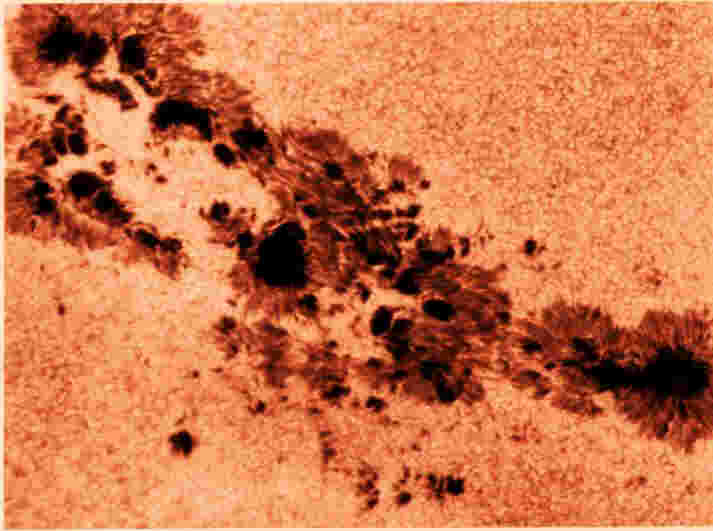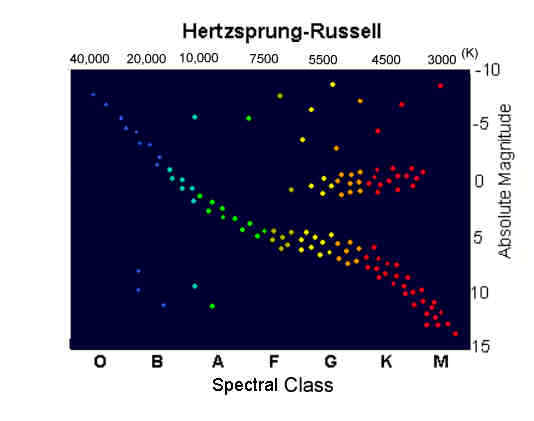The Sun is a star. A self-luminous sphere of gas and
plasma that is held together by its own gravity, and energized by nuclear
reactions in its interior. The Sun has a four part structure. The outermost
layer is the corona, the Sunís outer atmosphere. This is a zone of super
hot (temperatures vary, but range to millions of degrees centigrade). The
corona is periodically hit by shock waves released from the Sunís surface.
Combined with its high temperature, this produces the solar wind, a stream
of subatomic particles that are "blown" or projected outward from
the Sun. The solar wind moves at speeds of over 400 km/sec (893,000 mph) and
extends well beyond the edge of the Solar System. Below the corona is a thin
layer called the chromosphere, which is less than 200 kilometers thick. This
lower part of the Sunís atmosphere is composed mainly of hydrogen, and has
an average temperature of 5,000 Co. Chromosphere means
"color sphere", because when visible, this layer appears as a thin
red crescent. The corona and chromosphere are visible only during solar
eclipses, when the remainder of the Sun is hidden.
The visible surface layer of the Sun is the
photosphere, which is a layer of plasma about 300 kilometers thick. It is
composed of 94% hydrogen and 6% helium. Viewed from Earth, the photosphere
has a grainy or spotted texture of light and dark patches. This texture is
caused by temperature variations in the photosphere: the hot areas look
brighter than the dark areas. These variations are caused by circulation
within the photosphere. The photosphere also has a magnetic field, but
unlike the magnetic fields of the planets, the lines of magnetic force here
wind around the Sunís rotational axis, following lines of latitude rather
than lines of longitude. The reasons for this are not fully understood.
The remainder of the Sun is its interior or core. The
core consists largely of plasma composed of the nuclei of hydrogen atoms.
Deep within the core, the temperature is approximately 15 million degrees
centigrade. It has been calculated that a pinhead of material at core
temperature would be lethal to a person who was 160 kilometers away!.
The pressure in the core is also enormous. It is
calculated to be 70 trillion grams per square centimeter. The main feature
of the Sun, of course, is that it radiates energy. This is caused by nuclear
fusion. At core pressures and temperatures, four hydrogen nuclei undergo a
series of fusion reactions, which eventually produce one heavier atom of
helium. This process releases a huge amount of energy. This energy radiates
into space, mostly as infrared and visible light. Other wavelengths,
including ultraviolet radiation and gamma rays, are also emitted. Fusion
reactions happen relatively rarely in the Sun, so it burns its hydrogen
"fuel" fairly slowly. The Sun has been undergoing fusion for
around 5 billion years, and should last another 2 billion years before it
depletes is hydrogen.
|

Sunspots
|
The magnetic fields of the Sunís photosphere are
likely responsible for sunspots. Sunspots are patches of cool material on
the Sunís surface, up to thousands of kilometers in diameter. Sunspots are
transient; they generally last a few weeks to as much as two to three
months. The number of sunspots varies over an 11 year cycle. From a minimum,
the number of spots increases to a maximum in about 4 years, then wanes to a
minimum in another 7 years. In the Pre Lab, students will examine a graph of
sunspot activity, and try to recognize this pattern.
The Sun is about 1.39 million kilometers in diameter.
Its mass is 2.0 x 10 30 kg, about 330,000 times that
of the Earth. These dimensions are close to the average mass and size of
most stars in the Galaxy.
Astronomers classify stars using the Hertzsprung-Russell
(or H-R) diagram, which is shown below and on the worksheet. This diagram
arranges stars according to their brightness (y-axis) and temperature
(x-axis). On the H-R diagram, the Sun classifies as a main sequence star,
specifically a G2 dwarf star. The spectral intensity is the wavelength of
light released by the star, which for the Sun gives it its characteristic
yellow color.

PROCEDURE:
- Introduce the students to the Sun. Make sure that
they have an understanding of sunspots.
- Go over the graphs on the worksheet, making sure
that the students understand and can read both of them.
- Have the students complete the graphs. Make sure
they understand that the x axis of the H-R diagram changes
logarithmically. We recommend that they work in pairs, to aid in
interpreting the graphs.
ANSWERS:
- The students should recognize the 11 year sunspot
cycle. They may generalize this to 10 years, which is acceptable, given
the scale of the graphs. To mathematically determine the cycle, either
measure the number of years between minimums and calculate the average,
or do the same with maximums.
- A. blue giants = 8,000 - 9,000įK
B. orange = 5,000-4,000įK
C. Red = 3500-2500įK
D. white dwarfs = 9,000-10,000įK .
These are approximate values. Give students some latitude in their
answers.